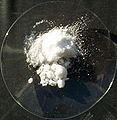Ammonium chloride
| Structural formula | ||||||||||||||||||||||
|---|---|---|---|---|---|---|---|---|---|---|---|---|---|---|---|---|---|---|---|---|---|---|
 |
||||||||||||||||||||||
| General | ||||||||||||||||||||||
| Surname | Ammonium chloride | |||||||||||||||||||||
| other names | ||||||||||||||||||||||
| Molecular formula | NH 4 Cl | |||||||||||||||||||||
| Brief description |
colorless crystals |
|||||||||||||||||||||
| External identifiers / databases | ||||||||||||||||||||||
|
||||||||||||||||||||||
| Drug information | ||||||||||||||||||||||
| ATC code | ||||||||||||||||||||||
| properties | ||||||||||||||||||||||
| Molar mass | 53.49 g mol −1 | |||||||||||||||||||||
| Physical state |
firmly |
|||||||||||||||||||||
| density |
1.52 g cm −3 |
|||||||||||||||||||||
| Melting point |
decomposes at 338 ° C |
|||||||||||||||||||||
| Vapor pressure |
1.3 h Pa (160 ° C) |
|||||||||||||||||||||
| solubility |
good in water (372 g l −1 at 20 ° C) |
|||||||||||||||||||||
| safety instructions | ||||||||||||||||||||||
|
||||||||||||||||||||||
| MAK |
Switzerland: 3 mg m −3 (measured as respirable dust ) |
|||||||||||||||||||||
| Toxicological data | ||||||||||||||||||||||
| Thermodynamic properties | ||||||||||||||||||||||
| ΔH f 0 |
−314.6 kJ mol −1 |
|||||||||||||||||||||
| As far as possible and customary, SI units are used. Unless otherwise noted, the data given apply to standard conditions . | ||||||||||||||||||||||
Ammonium chloride is the ammonium salt of hydrochloric acid . It is a colorless, crystalline solid with the chemical formula NH 4 Cl.
Occurrence
Naturally occurring ammonium chloride is known as the mineral ammonia . The mineral is a solid that should not be confused with an aqueous solution of ammonia, known as ammonia .
Extraction and presentation
Ammonium chloride can be obtained by neutralizing aqueous ammonia solution with hydrochloric acid or by reacting gaseous ammonia with gaseous hydrogen chloride .
Ammonium chloride occurs as a by-product in the extraction of soda using the Solvay process :
properties
Ammonium chloride is a colorless, water-soluble salt that forms cubic crystals. Aqueous solutions are slightly acidic - the pH value of a 1% solution is around 5.5. Ammonium chloride is poorly soluble in ethanol and insoluble in acetone and ether .
Ammonium chloride dissociates as the temperature rises
increasingly to ammonia and hydrogen chloride . The decomposition temperature, which is 338 ° C at normal pressure , increases with the pressure, according to the principle of the smallest constraint , until the salt melts at 34.4 bar and 520 ° C. When ammonium chloride is mixed with strong bases (such as sodium or potassium hydroxide solution ), gaseous ammonia is released, when mixed with low-volatility concentrated acids (such as sulfuric or phosphoric acid ) hydrogen chloride is released.
use
Ammonium chloride is used today, among other things, for the production of cold mixtures , in dyeing and tannery . It is also used for tinning, galvanizing or soldering, as it has the ability to form lightly smoking and weakly adhering chlorides with metal oxides and thus to clean the metal surface. It is also used as an electrolyte in zinc-carbon batteries .
Ammonium chloride is used in medicine as an expectorant . For this it is z. B. in salmiak liquorice ( salmiak pastilles ) contained. In addition, the Tobacco Ordinance allowed ammonium chloride to be added to snuff and chewing tobacco.
With ammonia offset ammonium chloride solutions as a chemical buffer to be used. It is also commonly found in white smoke powder . Together with alkali nitrates, it is used as a component in weather explosives . It is also used to remove soot from chimneys, tiled, coal and oil stoves.
Ammonium chloride on a watch glass
Formation of ammonium chloride in the gas phase
Formation of ammonium chloride from ammonia and hydrochloric acid
toxicology
Daily doses of eight grams of ammonium chloride led to acidosis after several weeks in one reported individual case , which also determines the symptoms at higher doses. Caution should be exercised if the patient has liver or kidney disease or if there is a potassium deficiency.
literature
- Helga Dittberner: On the history of Salmiaks in Islamic and pre-Islamic chemistry , Rete 1 (1972), pp. 347-363.
- Pradyot Patnaik: Handbook of Inorganic Chemicals . McGraw-Hill, New York 2002 ISBN 0-07-049439-8 .
- Julius Ruska: Sal ammoniacus, nusâdir and Salmiak , session reports of the Heidelberg Academy of Sciences: phil.-historical class, 14 (1923), 5, pp. 3–23.
Web links
Individual evidence
- ↑ Entry on AMMONIUM CHLORIDE in the CosIng database of the EU Commission, accessed on February 26, 2020.
- ↑ Hans-Dieter Jakubke, Ruth Karcher (Ed.): Lexicon of Chemistry , Spectrum Academic Publishing House, Heidelberg, 2001.
- ↑ a b c d e f Entry on ammonium chloride in the GESTIS substance database of the IFA , accessed on February 19, 2017(JavaScript required) .
- ↑ Entry on ammonium chloride in the Classification and Labeling Inventory of the European Chemicals Agency (ECHA), accessed on February 1, 2016. Manufacturers or distributors can expand the harmonized classification and labeling .
- ↑ Swiss Accident Insurance Fund (Suva): Limit values - current MAK and BAT values (search for 12125-02-9 or ammonium chloride ), accessed on November 2, 2015.
- ↑ Entry on Ammonium chloride in the ChemIDplus database of the United States National Library of Medicine (NLM), accessed on July 31, 2018 or earlier.
- ↑ PAETEC Formula Collection Edition 2003, p. 116.
- ↑ J. Köhler, R. Meyer, A. Homburg: Explosivstoffe , 10th edition, Wiley-VCH, Weinheim 2008, ISBN 978-3-527-32009-7 .
- ↑ Ammonium chloride acidosis. In: British medical journal Volume 2, Number 5249, August 1961, p. 441; PMC 1969339 (free full text).










